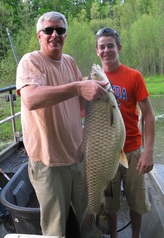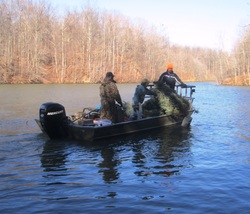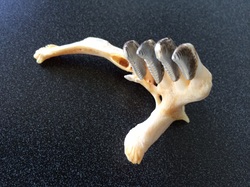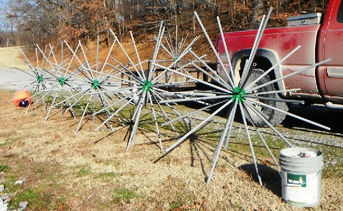 Walt Bradshaw with his son Walt Bradshaw with his son (40+ pound grass carp) Picture taken in 2010 Fish love structure! Most fish need structure in which to hide, to hunt and to spawn. Small fish feel stressed without it and rightly so! Without cover to hide in or behind they are easy prey for the ever present predators. Predator fish love structure from which to pounce on their next meal. And most fish prefer spawning in, near or on structure to provide cover for their newly hatched fry. Structure is necessary for a healthy and vibrant fishery. My problem was that when I acquired Fyrne Lake in 2004 there was virtually no structure. Like many manmade lakes, its bottom was totally cleared of trees and debris during its construction in 1978. Luckily, as the lake filled, birds and wind brought in aquatic plant seeds which quickly took root and began multiplying. This plant growth provided the cover the newly stocked fish required to flourish and in just a few short years Fyrne Lake (known as Viar Lake until 2004) provided excellent fishing. There was only one problem. A few of the fisherman complained to the former owner that the plants made it difficult to get their lures to the fish. That reinforced his fear that these aquatic plants might take over the lake. He didn’t need to worry.  Christmas trees staged for placement Christmas trees staged for placement Picture taken in 2012 For a healthy fishery, at least 5% to as much as 25% of a lake should be dominated by aquatic plants. Most of our area’s native aquatic plants require depths of 6 feet or less to flourish. Fyrne Lake is a deep lake averaging 15 – 18 feet with most depths away from cove ends reaching beyond 6 feet not far from shore. There was little chance that Fyrne Lake would ever develop a weed problem. However, the previous owner panicked and overreacted by stocking too many grass carp. A few may have been OK. However, he stocked about 1000 too many. It didn’t take long before these grass carp ate every shred of aquatic plant in the lake. White Amur, commonly called grass carp, are an Asian minnow species that can grow up to 100 pounds! They’re vegetarians and can consume 2 to 3 times their weight each day. Unlike the common carp which has a sucker like mouth, grass carp have a normal mouth followed by a series of teeth in their throat that tear plant material as they swallow. These plant eating machines made short work of the existing aquatic plants and then set their sights on the leaves within their reach on tree branches overhanging the water. Soon the bottom of the trees along the shoreline looked manicured! The trees were beautiful and the water was clear of weeds. The owner was happy and the fisherman could cast where they wanted. The problem was that the lake was back to having virtually zero structure. The gamefish fry and baitfish had nowhere to hide which allowed the larger gamefish to have a field day consuming everything in sight. Soon the lake reached an unhealthy equilibrium, zero baitfish, quickly consumed gamefish fry, gigantic bream (the ones too larger to be eaten by bass) and an overpopulation of stunted bass. As I stated in a previous article, bass tend to overpopulate and stunt in manmade lakes anyway. However, this lack of cover sped up the process. And by the time I had purchased the lake in 2004, it had been in dire need of care for many years.  Right side of grass carp jaw, showing the Right side of grass carp jaw, showing the throat teeth used for shredding plant material, as the fish swallow. In my last article, I shared with you our three prong lake management plan for Fyrne Lake. Removing unwanted fish (yellow bass “stripes”, catfish, grass carp & largemouth bass under 12”), pumping up the food chain, and adding substantial amounts of fish structure. Removing the grass carp would help me add acres of natural fish structure in the form of aquatic plants. We started removing every grass carp we could through netting and electro-shocking. We even put a bounty (a Fyrne Lake honey bear) on the head of any grass carp brought in by a fishing club member. One by one we began removing these 40 pound plus monsters. However it was going to take years before we removed enough grass carp to make a difference. We needed to find other ways to add natural and artificial structure now! I came across a product at a bait shop that was at that time call the O-No Hang Fish Attractor (the name eventually was changed to The Porcupine Fish Attractor). It was a unique looking contraption with a central globe and 26 holes to accept ½” diameter PVC pipe. The inventor, Larry Harper, lived in Paducah, KY and was at the time doing all of his own marketing and sales. I gave him a call and made a deal on 100 O-No Hangs. I was excited and so was he! It wasn’t long before he showed up with all 100 attractors and almost as many questions. Larry was a crappie fishing fanatic and had created his invention for fisherman to create their own fish attractors in public waters. I owned private waters and he was on a research mission to understand what opportunities might exist for him and his product in this market. I did my best to answer his questions and went further by introducing him to lake management firms who served private lake and pond owners. He was thrilled and it wasn’t long before we had a deal on an additional quantity of attractors. In addition to the Porcupine Fish Attractors, we cut down trees along the shoreline that were leaning over the lake. They would have eventually fallen anyway… I just didn’t want to wait! We also created stake beds out of cane and bamboo. I discovered a video at Crappie101.com (http://www.crappie101.com/crappie/how-create-a-crappie-stake-bed) that not only described how to make an effective stake bed, but also how to construct a tool out of PVC pipe that speeds installation. The tool enabled us to place hundreds of 4-5’ long cane/bamboo posts in just a few hours. Our efforts were beginning to make a difference! These various structures were gathering fish making them easier to be caught by fisherman. However these structures did not provide much cover for minnows or small game fish fry. We needed mass quantities of dense shallow cover for them. Again, I knew that aquatic plants would be THE ideal answer and someday these plants would return. For now we needed another way. We started out trimming tree branches along the shoreline and laying them down in the shallows creating mini-brush piles. We also took advantage of a temporarily available free source of structure… discarded Christmas trees! Their use is not a new concept, nor do they last very long (3-5 years on average) but, they were exactly what we needed to add dense, shallow cover for baitfish. We placed multiple Christmas trees horizontally, in shallow water, weighed down by cinder blocks. We also vertically dropped groups of trees in deeper water, with cinder blocks attached to the bottom of their trunks, causing them to settle down into the mud as if they had been planted. In deeper water installations we thinned out some of the Christmas tree branches allowing larger fish to hide between them. Using temporary floats to mark the location of each tree as we sank them, allowed the creation of accurately spaced forests of fish habitat!  Here is one of the five deep-water structures installed in 2012 Here is one of the five deep-water structures installed in 2012 Each one consisted of five Porcupine Fish Attractors, threaded into crab trap rope, held up by an inflatable offshore float and kept in place with five gallon bucket filled concrete. Photo by author Our efforts were adding up and the fish and fishermen were responding positively. However, we weren’t done yet! Fyrne Lake is a deep lake, much of it over 20’ with some areas approaching 40’. With the addition of our open water baitfish (the threadfin shad discussed in our last issue) and our increasing crappie population, deep water structure could add a new fishing dimension to the lake. I had an idea! In the ocean, greenbacks (the threadfin shad’s saltwater cousin) gather in huge schools around buoys and other offshore structures. What if we created an offshore structure of our own! I envisioned creating a buoy type structure in 30+ feet of water that would include attachments from the surface to the bottom. However, I did not want to only create one, I wanted 5 located within a 40 foot square area to ensure we give this new idea a fair shot at success. Each assembly would consist of a large float suspending five of Larry’s 60” tall Porcupine Fish Attractors threaded with crab trap rope and held down by a 5 gallon bucket of concrete. The key would be locating a float that was rugged enough to stand the test of time and large enough to hold up the weight of the attractors but not lift the 5 gallon bucket. I computed the weight of each and started making calls. It wasn’t as easy as I thought! Even though commercial type floats are rated by weight buoyancy, their engineers couldn’t tell me at what point they would stop lifting making it difficult to determine how much weight I needed to hold each structure in place. Undaunted, I would just have to do a little engineering myself! I ordered 5 inflatable commercial offshore buoys where I could fine tune their buoyancy, a role of crab trap rope, a few bags of concrete and enough ½” PVC pipe to assemble the attractors. By the time the floats arrived, we were ready! Ideally, I wanted the floats suspended just below the surface to be unnoticeable from shore. That would make installation tricky! Our plan was to tie the concrete filled bucket to the crab trap rope, lower the float to the bottom, thread and drop the 5 attractors on the rope one by one and then tie on the float. It sounded simple enough. But, I’ve discovered in life (more than once) that unexpected challenges can occur when a plan meets reality. In your head things like tying a knot in a rope seems simple enough and the first one that we tied on the bucket while it was still in the boat was easy. Threading the 5 attractors on the rope also went rather well. The unexpected knot challenge came while attempting to tie the float on the rope where I wanted it. That required the knot to be tied 3 feet under the surface! In my plan, one of us would just pull the rope up while another would tie on the float. Ha! We had about 100 pounds attached to that rope and one person leaning over the side of the boat could barely hold on. It took two people to lift and hold the rope while the third tied the knot. Whew! We tied it and let go. The float didn’t submerge! Even though I had pumped what I thought was the minimum amount of air in the float it was still too buoyant and the whole assembly started floating away! We retrieved the float and let out some air. It still lifted the concrete bucket off the bottom! After a couple tries we finally had the first structure suspended just below the surface. But, there were still 4 to go! We added a concrete block as extra weight to the second and it helped speed up the process. Eventually, after a lot of on the spot reengineering, we had all 5 buoy supported fish attractors installed and ready to go! One out of the 5 floats protruded above the surface, but that was OK. Rather than lifting it out to retie the knot, we would just leave it as a reef marker. EVERYONE on the boat LOVED the idea! Next question… would this deep water structure work! I knew one way to find out. After a couple weeks of waiting, we slowly cruised over the area with our eyes glued to the depth finder screen. Fish were everywhere! The depth finder indicated that the attractors we holding schools of baitfish just as I had hoped. It was now only a matter of time for the crappie and bass to follow. Every year we add structure to Fyrne Lake. Christmas trees are a given. We’ve partnered with the City of Dyersburg to recycle trees into the lake. We also keep an eye out for desirable bushes and tree cuttings left at two gullies nearby our farm’s entrance. And then there’s our experimental structures! Like the buoy attractors, we’ve always trying out new ideas to keep our fish and fisherman happy! Some have worked well, others haven’t. I promise to share with you the best of our ideas in one of my future articles. |
AuthorKevin Griffith Archives
September 2018
Categories |
 RSS Feed
RSS Feed